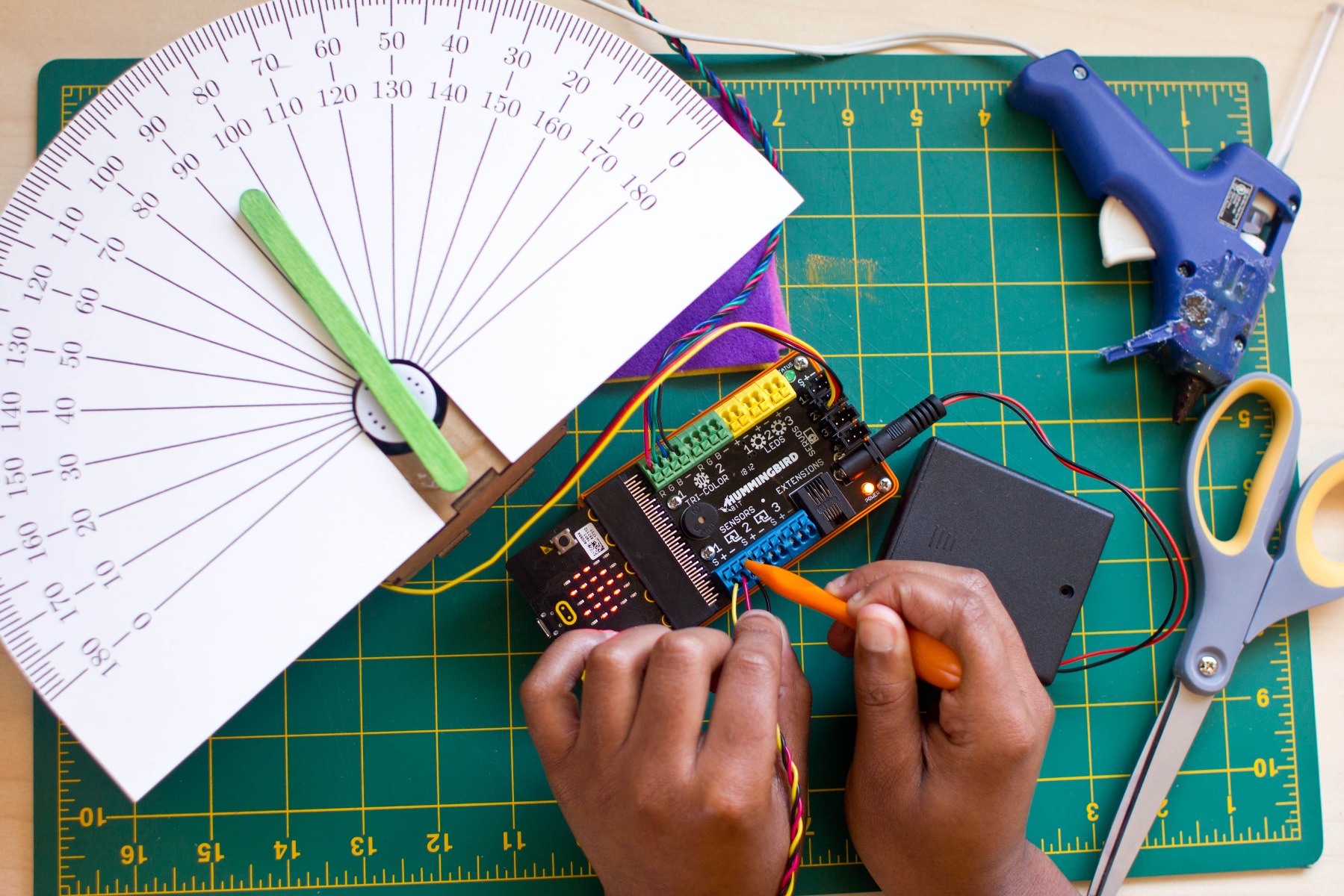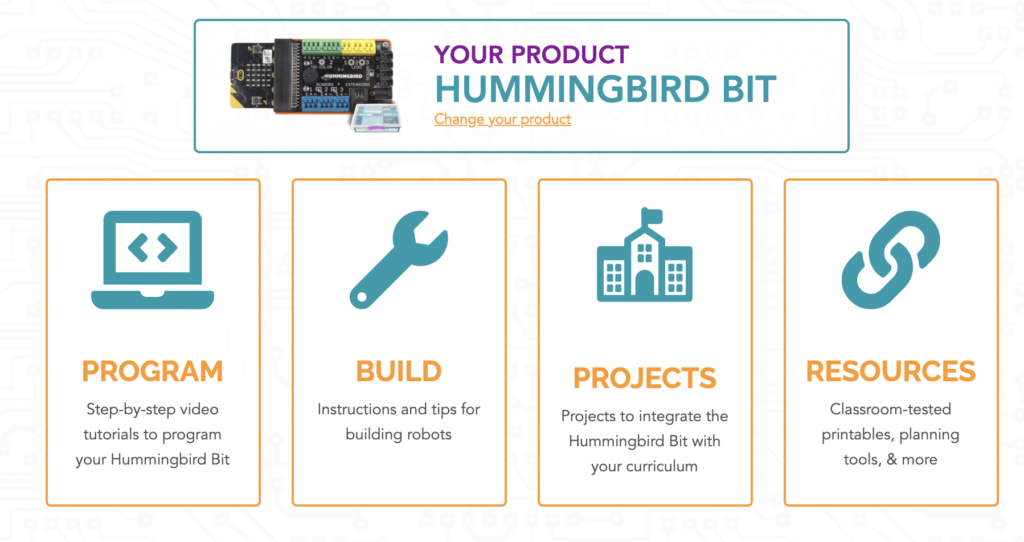The Hummingbird Bit is a DIY robotics solution that's perfect for just about any educational environment. By combining the powerful brain of the micro:bit with a flexible robotic core and modular parts, the Hummingbird Bit delivers an educational experience that’s comparable with some of the most expensive robots available. It’s actually pretty affordable, though, and offers a whole lot of educational value for students. Plus, plenty of teacher support materials are available to help ease implementation in the classroom or distance learning.
The leaders of Hummingbird’s parent company, BirdBrain Technologies, truly believe that robotics technology could and should be in any classroom and used in any subject. It’s a complex goal, as any educator that has tried to introduce robotics in a history class might be able to attest, but one that's far from impossible, especially with the cross-curricular nature of today's instruction. In order to be used in every classroom, however, a robot needs to be intuitive, easy to program, and help create connections to all subject matter. It also has to be easy to modify in order to use in different types of projects. And, that's what you get with the Hummingbird Bit.
Like the Finch 2.0 from BirdBrain, the Hummingbird allows students to practice coding in many different languages. No matter their age or previous programming experience, there's an option for them. BirdBlox is the most simplistic. It's block-based and designed for early elementary students. It's available on iOS, Android, and Fire OS devices. Then, we have MakeCode, which is often used with the micro:bit. This is also a block-based language (text coding is also available) for use with Chromebooks, Macs, Windows, and Linux computers. Then, there's Snap!, which is a bit more advanced. It's block-based as well and compatible with Chromebooks, Macs, and Windows computers.
For older students or more advanced coders, the Hummingbird Bit can also be used with three text-based programming languages. The first of those is Python, which is available on Chromebooks, Macs, and Windows computers. Next, we have Java, which works only with Mac and Windows devices. Then, there's Swift, which is Apples's text-based iOS builder. Coding with the Hummingbird and Swift can only be done on Mac computers. There's also one additional option called Kotlin. This is a text-based Android app builder that is available on Macs and Windows computers.

All of the Hummingbird Bit’s parts can be placed separately from the main chassis as long as you have a long enough wires to connect them. Because the Hummingbird uses plain wiring and push terminals to connect modules to its main body, resourceful students can assemble creations using any building materials they can find. This shows how the spirit of the Maker Movement and artistic creativity are a part of the Hummingbird Bit. It’s equally viable to use with building blocks or cardboard—a quality the BirdBrain team loves. One example that is unique is using the Hummingbird Bit in a Biology class with a skeleton arm that demonstrates tendon movement. You can learn more about the unique ways in which BirdBrain's robots help students explore STEAM in their PD videos.
The push terminals in the Hummingbird Bit add a certain level of engineering realism. They’re the same kind of push terminals you might see in a professional Arduino assembly, and rarely see with pre-built robotics kits. This kit comes with some sensors, motors, and LEDs. It also has an extension port for adding any sensors and tools supported by BirdBrain’s interface. That compatibility list is huge, due to Hummingbird’s use of the code.org infrastructure and its compatibility with the micro:bit. Two of the common sensors used with the Hummingbird Bit are a light and sound sensor. This allows students to include events based on these stimuli in their Hummingbird programs.

The micro:bit acts as the brain of the Hummingbird Bit. By itself, it can create sounds, display messages on an LED matrix, and respond to button presses. While it’s a powerful coding tool on its own, the Hummingbird Bit can transform the micro:bit from a computer into a robotics system. It's also easy for educators to start out thanks to the various Hummingbird tutorials that are available. When starting, users can choose a robot on the BirdBrain site and find relevant resources to help (above).
Those free instructional materials allow educators to learn about teaching with the Hummingbird Bit. They include straight-to-the-point videos on different Hummingbird robot coding options and creative project ideas for students. There is also a project library specifically for the Hummingbird Bit or the Hummingbird Classroom Kit. Educators can select their robot and grade level and find projects tied to specific STEAM disciplines. The BirdBrain Technologies team has also created adaptable curriculum for teachers who are using the robots in their own classes. We’d wholeheartedly recommend the Hummingbird Bit as that final step between learning the basics of coding and building creations on the fly!
In the case of the Hummingbird Bit, in particular, it fits in just about any subject with lots of opportunities for open-ended learning. Plus, the appeal of being able to dismantle and reassemble projects in a different way is a great feature! To learn more about the various Hummingbird Bit kits (classroom packs are also available with our without micro:bit boards), click below to visit the Eduporium store. Check out the Hummingbird Hacks on the BirdBrain website as well! For more information on EdTech, STEM, and robotics tools, be sure to follow our updates on Twitter, Instagram, and Facebook.





